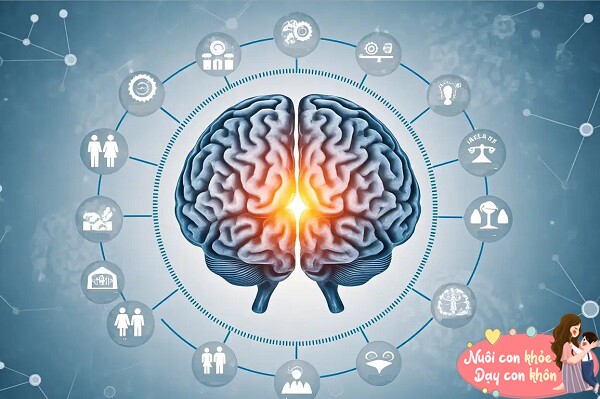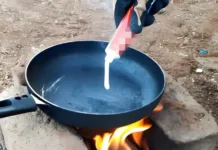Shouting at children when they misbehave may seem like the most direct solution. However, there are often “storms” occurring in their brains, affecting their cognitive development.


Amygdala: Emotions Overwhelmed by Fear
In a neuroscience program, scientists displayed a comparative brain scan: the amygdala of children who have endured verbal abuse over a prolonged period will appear in red, indicating abnormal activity. This region of the brain, responsible for processing fear and anxiety, will consistently show heightened activity.

When a child spills milk and is yelled at, their instinctive reaction may be to cover their head and ears, and their body might start trembling uncontrollably. This hypersensitive stress response is a result of the amygdala functioning continuously at a high load.
When a child’s brain is inundated with fear-inducing hormones for an extended period, the prefrontal cortex, responsible for rational thinking, will proactively “disconnect.” The human brain is akin to a computer; if too many programs run simultaneously, it may lead to a frozen state.
When children are frequently shouted at, they mostly cannot muster the cognitive resources to understand what they did wrong. Instead, they instinctively enter a “flight or fight” mode.

Hippocampus: Memory Erosion due to Stress
Research from Harvard Medical School reveals that children who experience frequent verbal abuse during their formative years may exhibit a 6% reduction in hippocampal volume on average.
The hippocampus is integral to storing and retrieving memories. When children are subjected to prolonged stress, memory impairment can occur.
Parents may notice that, at times, the more they scold, the less their children seem to remember. This is a classic manifestation of hippocampal injury—short-term memory cannot smoothly transition into long-term memory. It’s akin to using a bamboo basket to fetch water; no matter how much water is poured in, none can be retained.
It’s essential to understand that hippocampal injuries have a cumulative effect. Every time a child experiences a verbal outburst, their hippocampus’s memory storage capacity diminishes slightly.

Prolonged stress can lead to memory impairment.

Prefrontal Cortex: The “CEO of the Brain” in Development
The prefrontal cortex is recognized as the command center of the brain, responsible for higher-order functions such as decision-making, planning, and emotion regulation. However, this region of the brain doesn’t fully mature until around the age of 25 and is particularly susceptible to environmental influences.
Consequently, when children are shouted at, they may instinctively exhibit extreme reactions, either becoming defiant like a cat with arched backs or completely shutting down. These two extreme responses are indicative of prefrontal cortex dysfunction: either hypersensitivity or a sudden, unexpected blow.
More concerning is the potential for a vicious cycle. When children cannot utilize their rational brains to regulate emotions, they are more likely to engage in behaviors that further anger their parents.

The prefrontal cortex is the command center of the brain.

Language Center: Communication Channel Frozen
Neurologists have discovered that children raised in verbally abusive environments over extended periods exhibit significant degradation in neural connections in the Wernicke’s area (responsible for language comprehension) and Broca’s area (responsible for language expression).
Some parents complain that “My child is like a log, never speaking up, even when asked.” However, these parents may not realize that when they shout at their children, the children’s instinctive reaction is to go silent. Their language center seems frozen by fear.
Externally, the child remains silent, but internally, their world is locked away. When the gateways of the Wernicke’s and Broca’s areas are shut down by shouting, the bridge of communication between parent and child is disrupted.

Prolonged verbal abuse can lead to significant degradation in neural connections.

Gray Matter: Diminished Intelligence
Brain imaging experiments at the Max Planck Institute in Germany revealed that children exposed to prolonged verbal abuse had 14% lower gray matter volume than their peers. This gray matter is distributed across various brain regions, determining core cognitive functions such as thinking speed, memory, and judgment.
A concerned mother once shared: “My son used to be very intelligent, but now he struggles with even the simplest math problems.” This could be related to a reduction in gray matter. When the “hardware” of the brain is damaged, even the smartest “software” cannot function normally.
More importantly, this cognitive impairment has a delayed effect. Some children may not exhibit any abnormal behavior on the surface, but their brains resemble “stagnant water.”

Some children may appear normal on the surface, but their brains resemble “stagnant water.”
Breaking the Cycle
Change begins with awareness. When parents feel their anger about to erupt, they can try implementing a “three-minute rule.”
Physical Isolation Method: Step out onto a balcony, take deep breaths, count breaths silently, and allow calmness to return.
Emotion Labeling Method: Label the anger as “anxiety speaking, not my true self.”
Need Transformation Method: Change “I want my child to change immediately” to “We need to work together to solve this problem.”
Another approach is to create an “emotional safe haven.” Parents can establish a secret code with their children. When a child feels misunderstood or offended, they can use this code. Upon hearing the code, parents should refrain from lecturing and instead embrace their child, helping them rebuild trust in the world.
It’s never too late to repair the damage caused. The human brain possesses remarkable plasticity.
When parents begin nurturing their children with stable emotions, clear language, and warm hugs, those damaged neural connections will gradually regenerate.

































